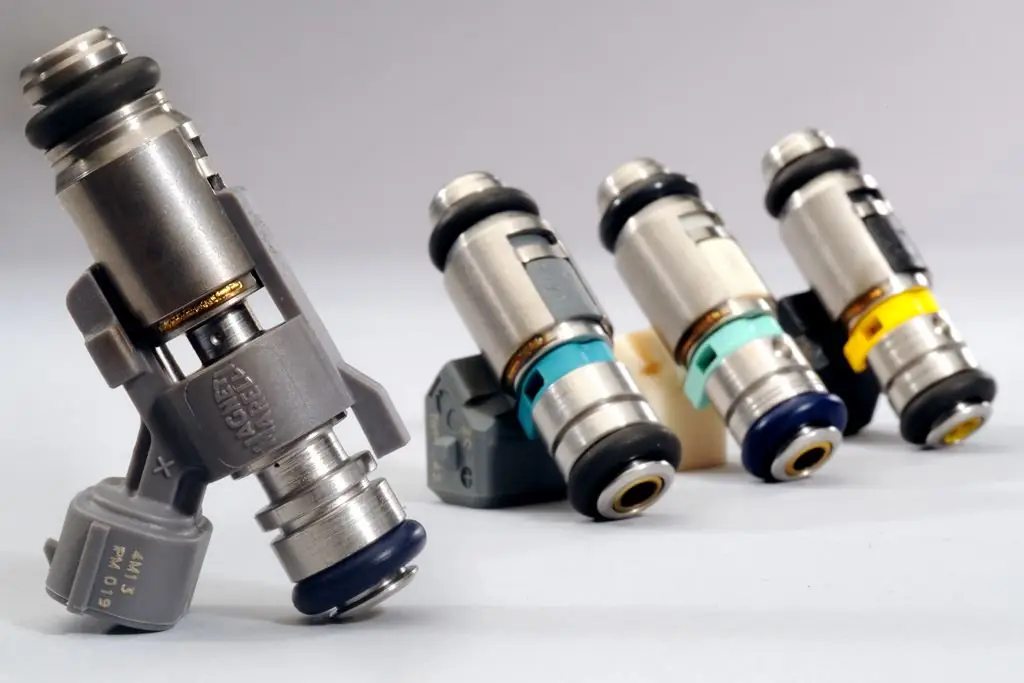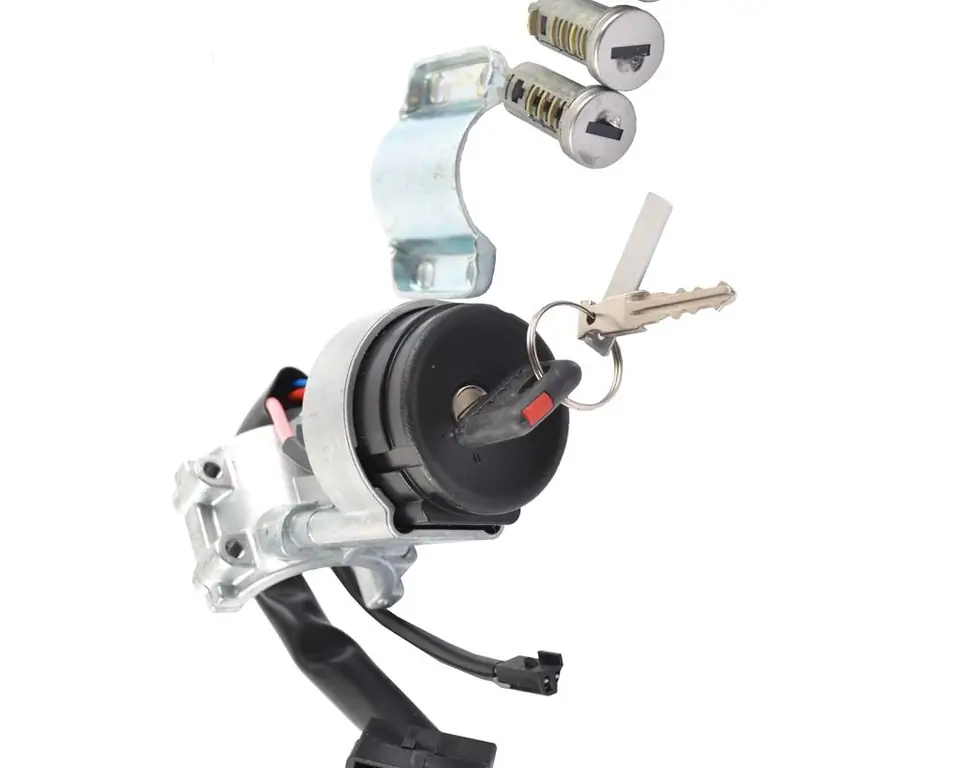2025 Author: Erin Ralphs | [email protected]. Last modified: 2025-01-22 21:14:12
The operation of the ignition switch (ZZ) in the Lada-Kalina car is not audible and hardly noticeable. It does not participate in the preparation of the working mixture, does not affect the speed of movement and is not able to extend the life of the engine. As a rule, they forget about him immediately after the start of the power unit. However, any damage to the lock, mechanical or electrical, makes it impossible to continue to operate the car. It simply cannot be turned on. Therefore, it is necessary to have at least minimal knowledge about the design of the Kalina ignition switch, the most common malfunctions and how to eliminate them.
General information
The purpose of the ZZ "Kalina" is no different from other cars - turning on the ignition and controlling the engine starter. It is equipped with a mechanical interlock and protection against restarting the starter without turning off the ignition. This allows you to protect the flywheel crown and bendix from accidentally turning the key. There is also electronic protection in the form of an immobilizer, the antenna of which is integrated into the ZZ.

The Kalina ignition lock has 3 positions, each of which is described in the table.
| Position | Consumers |
| 0 | Parking lights, radio, alarm, brake light, ceiling lamp |
| 1 |
Car ignition system, low and high beams, heater, washer and wipers, direction indicators, fuel pump. |
| 2 | Starter |
The key can only be pulled out in the zero position. In order not to forget it in the lock, with the engine off, an audible alarm is provided, which turns on simultaneously with the opening of the driver's door.
Design
The lock consists of mechanical and electrical parts. Briefly about the design of each of them:
- The mechanical part is a cylindrical mechanism, which can only be turned with a key designed specifically for it. In addition, this includes an anti-theft latch that prevents the steering wheel from turning.
- The electrical part consists of terminals and contacts, correspondingly closing with each turn of the key. To do this, it is connected to the mechanics of the castle. There are only three contacts. One of them, the thirtieth, is supplied with a plus, directly from the battery. The remaining two (15 and 50) are designed to turn on consumers and a starter, respectively. To limit the current through the fiftieth contact, a relay is included in its circuit. Through itcontacts, and not through the ignition switch "Kalina" the starter is powered.
The immobilizer antenna is located in the decorative ring that covers the EZ. It responds to the transponder of the key inserted into the lock. The immobilizer recognizes only its own unique signal and gives permission to the control unit to start the engine.

Faults 33
Most often, damage to the Kalina ignition lock is associated with its mechanical part. In this case, it is impossible to turn the key to the desired position. A malfunction does not occur, as they say, out of the blue. As a rule, within a few months, frequent jamming of the key is observed, which are eliminated by swinging it in the larva.
Rarely, but there are cases of failure of the electrical component of the Lada-Kalina ignition switch. Basically, they come down to the lack of contact when turned on. This is typical only for locks with a long service life. True, there is another common reason for burning contacts - the car owner himself.
When installing additional equipment, the owner of the machine does not take into account that the maximum allowable load on pin 15 is only 19 amperes. This is quite enough for regular consumers, but additional light and sound devices, especially those installed handicraft, the castle can no longer withstand. Contacts begin to spark and eventually fail. Therefore, when installing additional equipment, it is imperative to use an additional relay to power it.

Signs of malfunction
The main symptoms of GE damage are most often obvious:
- The key of the Kalina ignition does not turn. It should not be thought that it can only jam in the "0" position. Sometimes, on the contrary, the car cannot be turned off because the key does not return to the neutral position.
- A number of devices do not work, including the control lamps on the panel.
- Starter does not turn.
- There are constant interruptions in movement, with the disappearance of readings from control devices.
- Instrument panel lamps light up after several turns of turning the key in one direction and the other.
As with any malfunction, some symptoms do not necessarily indicate a lock. Therefore, before disassembling it, you need to exclude all other options. This can often be done indirectly. For example, if the starter does not rotate, but when the key is turned to position "2", the relay clicks, then the lock is working.

Repair or buy new
There is no single answer to this question. The fact is that it is very difficult to find a new contact group on the ZZ "Kalina", unlike the classics, "Samara" and the tenth family. Therefore, it has to be repaired, which without experience, skills and desire is not the best idea. Most often, owners install a new ZZ by purchasing it as an assembly.
In this case, it must be taken into account that the Kalina ignition switch with an immobilizer that will not respondThe new key won't start the car. Of course there is a way out. You can retrain the immobilizer with a new key. In this case, you will also have to change the larvae on the door locks.
You can do it easier - carry two keys with you. True, it is not clear whether it is worth keeping them on the same bundle. Therefore, the most reasonable thing would be to make a new "sting" and install it on the old key. By the way, it may be supplied with a new lock.

Replacing the ignition lock
As always, if the work is connected with electricity, you need to start it by disconnecting the negative terminal of the battery. From the tool you will need a curly screwdriver and a small chisel. You need to buy an ignition lock in advance. In this case, the presence of an immobilizer must be taken into account. If everything is ready, you can proceed to the replacement. The sequence of actions is as follows:
- Having unscrewed five bolts, remove the decorative cover of the steering column. The screws are different, so it's better to remember which one was where. In addition, to remove the cover, you need to lower the steering column adjustment knob.
- The ignition lock is fixed on two clamps, tightened with bolts that cannot be unscrewed with a key. Therefore, you will have to use a chisel. It needs to be rested on the hat and with neat, but rather strong blows, unscrew it until it becomes possible to do it with your hands. That is, you do not need to cut the bolt with a chisel, but use it as an analogue of the key.
- Thus, you will have to unscrew all 4 screws.
- The lock will remain hanging on the wires.
- Unplug the electrical connectors and the ignition lock can be easily removed.
- Install in reverse order.
It is worth noting that this sequence of actions is similar for all modifications of the car, including for the Kalina 2 ignition switch, produced since 2013

Conclusion
Like all VAZ cars, the Kalina ignition lock does not need periodic maintenance and is designed for long-term operation. True, this is true, only if the rules of operation are observed. Therefore, it is necessary to prevent moisture from entering the lock and not to exceed the maximum allowable current through its contacts.
Recommended:
CDAB engine: specifications, device, resource, principle of operation, advantages and disadvantages, owner reviews

In 2008, VAG group cars entered the automotive market, equipped with turbocharged engines with a distributed injection system. This is a 1.8 liter CDAB engine. These motors are still alive and actively used on cars. Many are interested in what kind of units these are, are they reliable, what is their resource, what are the advantages and disadvantages of these motors
The principle of operation of the variator. Variator: device and principle of operation

The beginning of the creation of variable programs was laid in the last century. Even then, a Dutch engineer mounted it on a vehicle. After such mechanisms were used on industrial machines
Dry sump: principle of operation, device, advantages and disadvantages

What features does a dry sump have and why is it better than a wet sump? Everything you need to know about the ICE lubrication system: device, principle of operation, main characteristics, details, advantages and disadvantages
Damper flywheel: device features, principle of operation, advantages and disadvantages

The engine has a lot of critical components and mechanisms. One of them is the flywheel. It is this node that transmits the generated torque to the box through the clutch. Also, thanks to the flywheel, the engine rotates when the starter is engaged (when trying to start). In addition, the unit is designed to dampen vibrations and vibrations, and smoothly transfer forces to the box. In today's article, we will pay attention to such a type of mechanism as a damper flywheel
Carburetor and injector: difference, similarities, advantages and disadvantages of carburetor and injection engines, principle of operation and expert reviews

For more than a hundred years, the car has firmly established itself in our lives. During this time, managed to become a familiar, everyday means of transportation. Let's see what the difference is between a carburetor and an injector, what advantages and disadvantages they have

